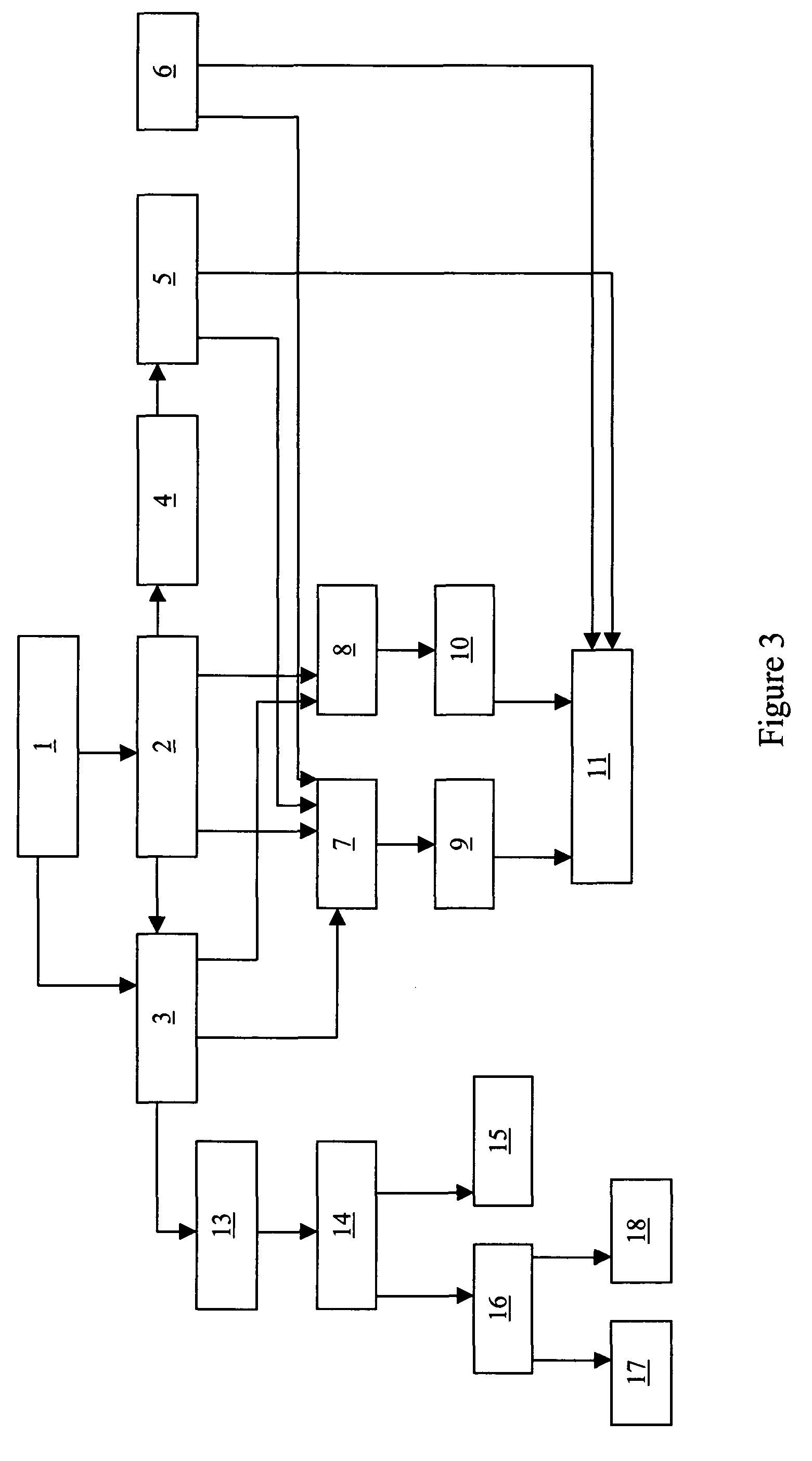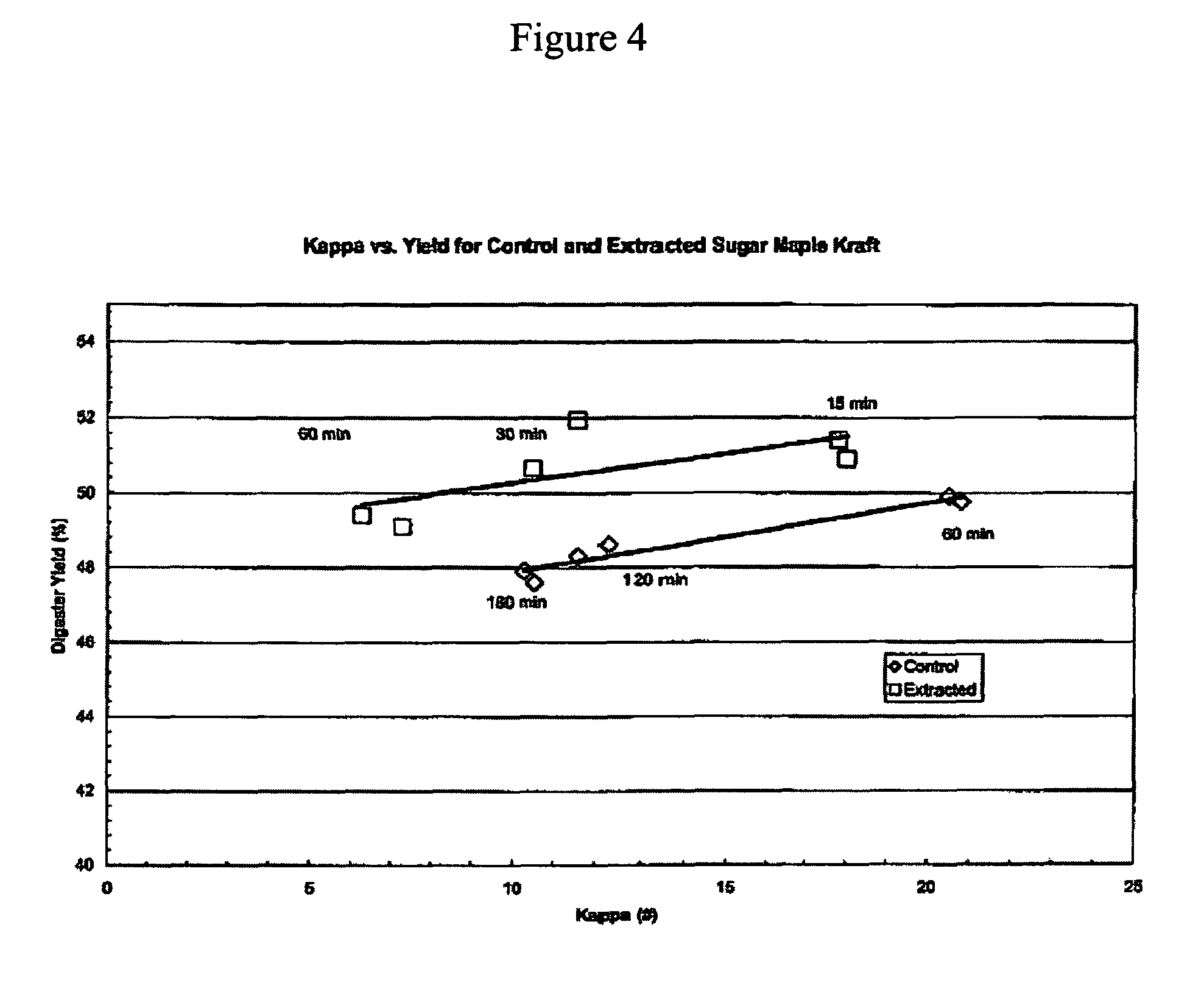Product and processes from an integrated forest biorefinery
a biorefinery and integrated forest technology, applied in the field of pulping and bleaching lignocellulosic materials, can solve the problems of limiting the number of pulp applications, high energy cost and damage to lignocellulosic fibers, and limiting the number of applications
- Summary
- Abstract
- Description
- Claims
- Application Information
AI Technical Summary
Benefits of technology
Problems solved by technology
Method used
Image
Examples
example 1
Picea abies Preparation
[0080]Picea abies (Norway spruce), a softwood was utilized in this example. However, different species of woods, including hardwoods and / or softwoods, can also be used. Moreover, the invention can be used with virgin wood or waste wood, including, e.g., kiln dried, air-dried and green wood from industrial, residential, sawmill, construction and demolition sources. In the present example, logs from a 79-year old tree were debarked with a 36-cm spoke shave, chipped in a Carthage 10-blade chipper, and air dried to approximately 15% moisture by spreading the chips on a tarp. The chips were then screened in a Williams classifier. All fractions were collected and the chips retained on 15.8, 12.7 and 9.25-mm screens were pooled together and sealed in plastic bags, and stored at room temperature (approximately 24° C.) for use throughout this study. TAPPI test method T-257 cm-97 was followed for all subsequent testing and samples were taken from the pooled material as ...
example 2
[0105]All hot water pre-extraction (HWP-E) for this example were done in M&K digesters. Alkaline pulping was conducted in the M&K digesters as well or in small autoclaves placed into the M&K digesters. Pin chips were used in the autoclaves. The extent of HWP-E varied from mild to severe.
[0106]The pulping parameters were adjusted for the cooking of pin chips since these cooks were done in 250 mL autoclaves. The cooking parameters were: AA 24%, Sulfidity 26%, and L:W 10:1. The autoclaves were brought up to 170° C. in 90 minutes and held there for 60, 120, and 180 minutes.
[0107]The extracted sugar maple pin chips were done similarly. The cooking parameters, except for the temperature profiles, were the same. These cooks were brought up to 170° C. in 60 minutes and held there for 15, 30, and 60 minutes consecutively.
[0108]Kappas and Viscosity Done to TAPPI Standard Methods
[0109]Exploratory Cooks for Yield Optimization
[0110]The exploratory cooks were carried out on standard sugar maple c...
example 3
Materials and Methods
[0143]Preparation of the Chips
[0144]Wood chips arrived in barrels from the SUNY-ESF Genetics Field Station in Tully, N.Y. The chips were from a single harvest at four years of age of a multi-clone trial. The chips were laid out for two weeks to air dry with a resulting oven-dry (OD) solids content of 92.3%. After air-drying, the chips were well-mixed and then divided and placed into large plastic bags for storage. It was important to bring the chips to a constant and low moisture content to ensure natural degradation did not take place during storage. When chips were needed for treatment, a 1625 gram air-dry (AD) chip sample (1500 g OD) was brought up to a 50% moisture content by soaking overnight in distilled water. Xylan in wood is fairly resistant to leaching at low temperatures due to the molecular size of the polymer molecule. The soaking was done at room temperature to minimize the loss of xylan during this step.
[0145]The chips were then incubated in an ae...
PUM
| Property | Measurement | Unit |
|---|---|---|
| temperature | aaaaa | aaaaa |
| temperature | aaaaa | aaaaa |
| kappa number | aaaaa | aaaaa |
Abstract
Description
Claims
Application Information
 Login to View More
Login to View More - R&D
- Intellectual Property
- Life Sciences
- Materials
- Tech Scout
- Unparalleled Data Quality
- Higher Quality Content
- 60% Fewer Hallucinations
Browse by: Latest US Patents, China's latest patents, Technical Efficacy Thesaurus, Application Domain, Technology Topic, Popular Technical Reports.
© 2025 PatSnap. All rights reserved.Legal|Privacy policy|Modern Slavery Act Transparency Statement|Sitemap|About US| Contact US: help@patsnap.com



